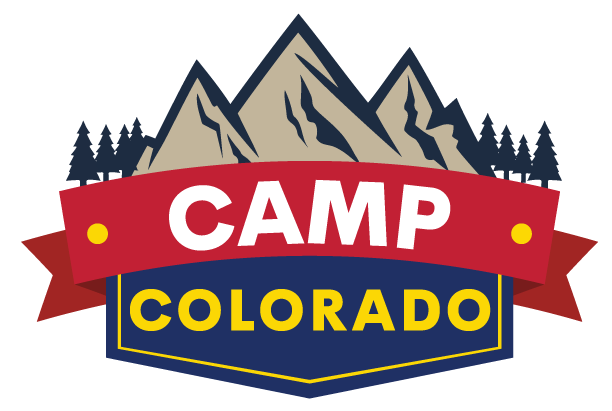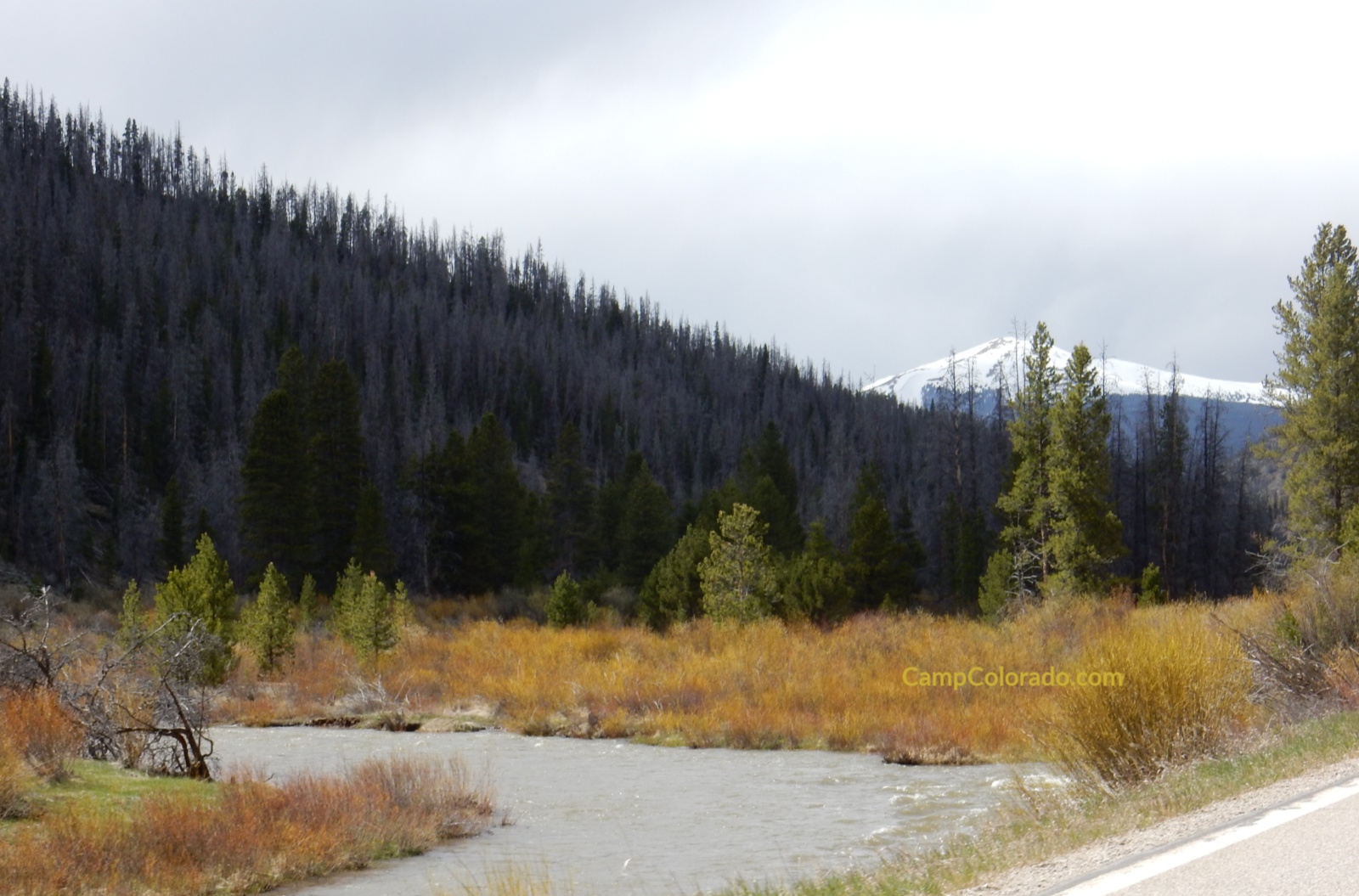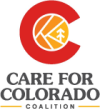In an earlier blog post, we introduced the eight regions of Colorado. Now let’s dive more deeply into each region (when we’re finished with each we’ll link them to one another).
This time we’ll visit the area known as The Great West region (shown in olive or greenish tan in the northwest portion on the map).
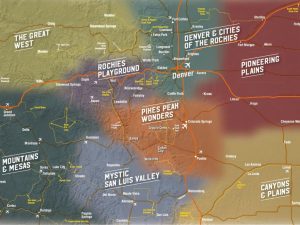
8 Tourism regions of Colorado (as shown by the Colorado Tourism Office)
The region borders on Wyoming and Utah, and it blends into three other regions in Colorado: Mountains and Mesas to the south (blog coming soon), Rockies Playground to the southeast, and Denver & Cities of the Rockies to the east.
Communities are a bit farther apart in this region, and they’re considerably smaller in population. Outdoors enthusiasts create most of the traffic!
You’ll find community names that perhaps conjure images from millions of year ago (e.g., Dinosaur) or geological features (e.g., Battlement Mesa, Steamboat Springs, and Grand Lake). A few communities have perhaps a more Native America origin (e.g., Yampa). Other communities you might recognize include Granby, Kremmling, Tabernash, and Walden.
TUNDRA
The tundra is an incredible “must see” in the region! Once the snow melts you can enjoy it on either side of US Hwy 34, while driving the 41-mile stretch of road called Trail Ridge Road (aka, Trail Ridge Road/Beaver Meadow National Scenic Byway). It traverses Rocky Mountain National Park from Estes Park to Grand Lake.
“The Trail Ridge Road is the highest paved through road in Colorado and it is also the highest paved road in Colorado that crosses the continental divide. … The road crosses the Continental Divide at Milner Pass (elev. 10,758 ft or 3,279 m) and reaches a maximum elevation of 12,183 ft (3,713 m), near Fall River Pass (elev. 11,796 ft or 3,595 m). Near the highest point on the road is another pass, Iceberg Pass (elev. 11,827 ft or 3,605 m).” ~Wikipedia.
If you haven’t seen the tundra with your own eyes, Trail Ridge Road is waiting for you!
Keep in mind, though, that the weather at this elevation means it has a short visitation season! The area typically opens in late May or early June, has been known to close for several hours or days even in the summer, and closes permanently when conditions change again in autumn.
SCENERY ABOUNDS
As if the tundra wasn’t scenic enough, let’s reveal other equally unique sections in The Great West.
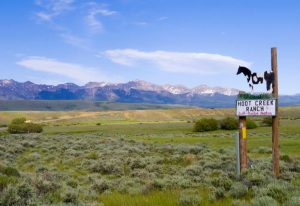
Cache la Poudre Byway (Colorado Tourism Office)
The community of Walden is in the center of the high-elevation, large valley called North Park. Here you’ll find yourself at about 8,100 feet above sea level.
Colorado.com says that North Park is “home to some of Colorado’s wildest landscapes. Around 65 percent of North Park is public land, and amid the abundant lakes, rivers, mountains and wide-open prairies, there’s only one thing missing: crowds.”
It’s also where the Poudre River begins its 126-mile flow, cutting a canyon through the Roosevelt National Forest in Poudre Canyon, and emerges in the down in the foothills near Fort Collins. “As you travel up the winding road, take time to pull over and watch the awesome force of the Cache la Poudre’s rapids.” ~ Colorado.com
We highly recommend the Colorado River Headwaters National Scenic Byway and Flat Tops Trail Scenic and Historic Byway. Scenery, nature, wildflife …. Colorado is fortunate to have so much it!
In contrast to the lush terrain of North Park, let’s now talk about the rugged Dinosaur Diamond Prehistoric Highway National Scenic Byway. This byway “takes drivers through landscapes that once shook under the footfalls of titans.” ~ Colorado.com
Dinosaur National Monument reminds us of our truly rich history, dating back millions of year!
Speaking of long ago, but not quite that long ago, Canyon Pintado National Historic District has “hundreds of archaeological sites, most deriving from the Fremont Culture (c. AD 0-1300) and Ute (c. AD 1300-1881)” ~ Colorado.com
WILDLIFE & TRAILS
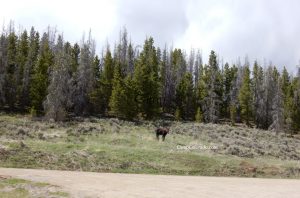
Moose in North Park photo by CampColorado.com
Moose! Now that’s a creature many believe is synonymous with Colorado. The Great West Region is actually home to the Moose Viewing Capital of Colorado, North Park. It’s true, and many people claim it was here they experienced their first ever moose sighting was in North Park!
Nature lovers and photographers will often all enjoy elk, mule deer, mountain lions, mountain goats, black bears, pronghorn, beaver, waterfowl, birds of prey, upland and migratory birds. The state animal is the bighorn sheep (more specifically it’s the official mammal). Colorado is home to the largest population of them anywhere. These handsome creatures are often seen along roadways, and they rarely bolt in front of you or bolt out of your path, so please go slowly and enjoy the view!
Wildlife of Colorado can also be seen by those who escape from the blacktop to enjoy Colorado’s countless off-road trails (hiking ones and those designated for ATVs). The national forests and other public lands offer many trails.
Speaking of trails, don’t overlook these:
- Browns Park Trail
- Continental Divide National Scenic Trail
- Devil’s Causeway
- Dinosaur Trail
- Kenny Reservoir Trail
FISHING
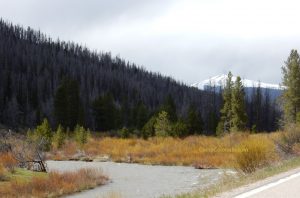
The Great West photo by CampColorado.com
Colorado offers thousands of miles of streams, plus over a thousand lakes and reservoirs, and The Great West region includes some of those! You will perhaps be able to catch kokanee salmon, brown, lake, rainbow trout, walleye, pike, smallmouth and largemouth bass, and yellow perch.
For more about fishing in Colorado’s thousands of places (including Wolford Mountain Reservoir, Steamboat Lake or on the Colorado River) please click here. Fishing licenses can be purchased online or in person.
MORE OUTDOORS
The Great West welcomes you in all four seasons. Whether it’s the drives or trails, water, geological formations, history, fishing, cycling, or winter sports, we feel camping in Colorado’s Great West offers a lot for everyone!
Speaking of winter, consider skiing in Steamboat Springs or rejuvenating at Steamboat Hot Springs.
We hope our brief overview here provides a glimpse into the abundance of natural attractions, national landmarks, federal and state parks, and essentially everything you need to escape from the real world for a fabulous Colorado adventure! There is so much waiting for you in The Great West!
WORDS OF WISDOM
- Altitude sickness is REAL and it’s PREVENTABLE! Before you book your campsite, please consider our suggestions (click here). Let your body adapt! Even one day can make the difference in the quality of your Colorado vacation.
- If you click on each link provided in this blog post, you will find much more historical and entertaining information!
- Those who book early have the best chance of finding campsite availability, especially for summer weekends and holidays.
- There are limited roadways compared to the eastern USA, so plan for this. Congestion can be an issue (especially Friday and Sunday evenings).
- Regardless of the time of day and time of year, be sure to monitor conditions on COtrip for the current road conditions. Construction, avalanche control, snow, ice, rain … Colorado can see all of it even in one day!
So, where should you camp in colorful Colorado? It depends on the month of your trip and your camping preferences from what amenities you desire to your means of lodging (tent, RV, cabin, yurt, lodge, tepee, covered wagon, glamping safari tent, or any other means of enjoying the outdoors). Since there are many other factors to consider, we created our CampColorado products to help you find a campground that suits your desires. The search page offers a range of options, and many listings provide in-depth descriptions.
The Colorado Tourism Office provides additional travel ideas in the regions in this post.
This publication is supported by funding from the Colorado Tourism Office, a state agency. Turn to Colorado.com for a comprehensive list of festivals, events, historic areas, itineraries, and community insight.
